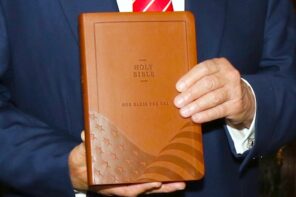In January 2018, the 45th president hit a new low in a closed-door meeting: “Why do we want all these people from ‘shithole countries’ coming here?” he reportedly asked. He was referring to immigrants from African nations, Haiti, and El Salvador, and asked why the U.S. couldn’t get more immigrants from, say, Norway instead. Condemnation swiftly followed from lawmakers on both sides of the aisle, but the condemnation wasn’t universal. As one White House official explained, the comments “would resonate with Trump’s base,” playing to a sense of American greatness and exceptionalism.
The tactical supply shop and social media site Tactical Shit, which boasts a “community of over 2 million veterans, first responders & patriots,” sells a “Shithole World Map Poster.” It shows the entirety of the world, save most of the U.S. (minus the coasts and other Democrat-leaning areas) and Norway, as brown colored shitholes—whether of the “Jungle,” “Desert,” “Poor/Hungry,” “Commie,” or “iPhone Factory” variety. The “Shithole World Map” is clearly meant to be funny, but that doesn’t mean it’s parody. The map reflects an American-centric view of the world that the 45th president stoked.
Trump’s followers weren’t delighting in simply shocking and outraging “the libs”; they were reaching back to a longer tradition of how to see the world—one with deep roots in religion. Back before Trump had the brazenness to label countries he disdained “shitholes,” Americans called them something more socially acceptable but equally condescending. They called them “heathen.”
The “Shithole World Map” and others like it are reminiscent of maps from the nineteenth century that color-coded the world by religion. In these maps, created by missionaries and their supporters to spur interest in and donations for foreign missions, the “shithole countries” were “heathen” and, as in the Tactical Shit map, colored in the drab hues of gray or brown. Contemporary mission organizations have continued the project of mapping the world by religion. Instead of “heathen” they now use euphemisms like “unreached people groups” or “frontier peoples,” but the underlying worldview of a blessed “us” and a backward “them” remains.
The religious outlook on the majority of the world as “heathen” reflects an older mentality—as does usage of the word itself. But just because the concept is older doesn’t mean it’s no longer influential: the idea of the “heathen world” continues to inform white Christian American exceptionalism and to shape Trumpian views of the rest of the world as squalid and woebegone. Heathenness has never been about “wrong” belief alone; it’s also about the myriad ways that wrong belief is supposed to manifest on “heathen” lands and lives.
The view of “heathen” lands as, essentially, shitholes, took inspiration from Isaiah 34 and 35, which detail the anger and judgment of the Lord against unbelieving nations, followed by their redemption. “And the streams thereof shall be turned into pitch, and the dust thereof into brimstone,” Isaiah 34 describes. “And thorns shall come up in her palaces, nettles and brambles in the fortresses thereof: and it shall be an habitation of dragons, and a court for owls.”
Nineteenth-century missionaries recognized apparent civilizational differences between various “heathen” regions, seeing some as undeveloped and others as overly developed and antiquated. But with Isaiah 34 as their viewfinder, they saw all these regions as fundamentally blighted and in need of restoration.
The “undeveloped” regions were thought to be unable to support their human inhabitants, who supposedly scrabbled for subsistence and lived in squalor, exposed to the elements. As one publication about South Africa put it, “the natives” live “like plants on a sterile soil, stunted in growth.” Are their “domiciles” even “the abodes of human beings?” missionaries asked.
Meanwhile, the “antiquated” regions—typically how missionaries described Asia—now teemed with so many humans that they, too, were supposed to live in squalor, constantly teetering on the edge of famine. At first glance, these regions and their histories seemed impressive to Americans from a young nation. But just as Isaiah explained that “thorns shall come up in her palaces,” so missionaries saw the built landscapes of India and China as decrepit and decaying beneath their gilded surfaces. One missionary described his impressions of India as “disgust[ing]” to “every sense”: “I thought, Surely it can get no lower without opening the mouth of hell.”
According to nineteenth-century missionaries, it was because “heathens” spent their time worshiping the wrong deities—spirits in nature, ancestors, idols—that they failed to improve their lands and their lives. And so, to the missionaries and the Americans who read their many publications, the “heathen world” was full of what Trump and his base would call “shithole countries.” And, just as Trump wanted to keep immigrants from “shithole countries” out of the US, so nineteenth-century Americans erected barriers to the immigration of “heathens” to their “Christian land”: case in point, the 1882 Chinese Exclusion Act.
But Isaiah 35 promised that “the desert shall rejoice, and blossom as the rose,” and missionaries saw themselves as the catalyst in making this happen throughout the suffering “heathen world.” They would make foragers into farmers, and in general make everyone more Western. The promise of saving the heathen and making the desert rejoice justified all manner of casualties along the way.
Twenty-first century Americans no longer look at maps of the world and see large swaths of heathens. And yet they do continue to look at the world and clump vastly different people and places together under the rubrics of the “Third World” and “developing countries.” The history of the “heathen world”—which I write about more in my forthcoming book, Heathen: Religion and Race in American History—helps to explain how Americans can see such different regions of the world as capable of being grouped together under the same heading, while seeing their own nation as categorically different and superior.
Most Americans don’t talk about “heathens” anymore. But when Donald Trump talks about “shithole countries,” we know all too well what he means. It’s just a cruder way of saying what’s been said in many American churches for generations, so that it’s become part and parcel of white Christian America’s cultural inheritance and global influence.
If we want to get rid of the “shithole country” mentality once and for all, we have to understand how deep and wide its roots really go.





